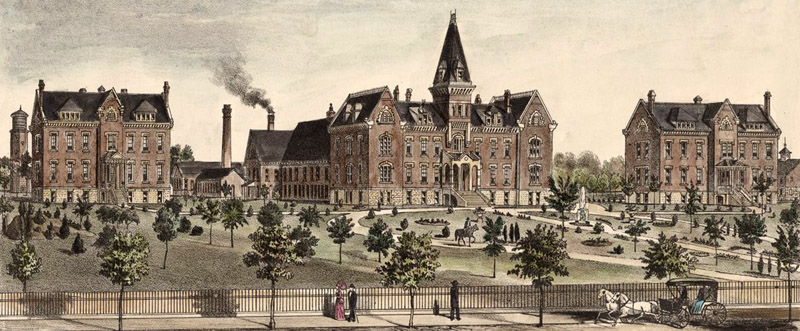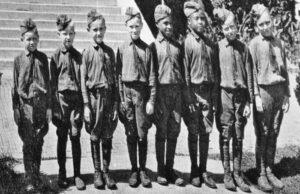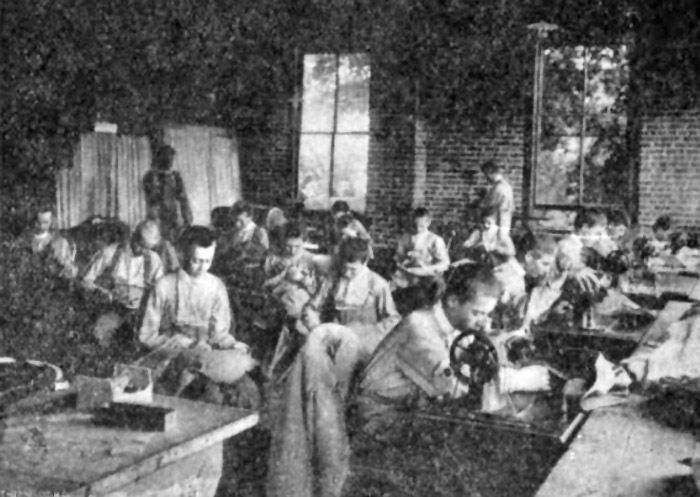This State Reform School was established under the provisions of an act passed by the legislature of 1879, which appropriated $35,000 to erect buildings, equipment, and supplies. The control and supervision of the school was placed in the hands of the board of trustees of the state charitable institutions, which was directed to select a site within five miles of the state house, provided the city of Topeka, Kansas, would donate a tract of not less than 160 acres of land for the purpose. It was Kansas’s first institution for juvenile rehabilitation.
Shortly after the act’s passage, the board appointed Dr. J.L. Wever, A.T. Sharpe, and C.E. Faulkner as a committee to visit other states and examine the workings of their reform schools. The committee reported in favor of founding an institution that should be educational rather than penal; that cells, bolts, and bars should be omitted; that none over 16 years of age should be admitted; that forms of trial in making commitments should be omitted as far as possible, and that there should be a complete separation of the sexes. The report was adopted, and the school was founded on that basis.
It was two and a half miles north of the capitol building on Soldier Creek. A brick and stone double cottage with wings was erected on a tract of 170 acres given by the city of Topeka, and 70 acres were added to this by purchase. When filled to its full capacity, it could accommodate 125 boys.
The school was opened for the reception of boys on June 6, 1881, under J. G. Eckles, Superintendent, and Mrs. Eckles, matron. Seventy-three boys were admitted during the first year, seven were discharged, six returned to the authorities, and twelve escaped. Of these boys, 56 were white, and 17 were black.
The school’s goal was to reform and care for dependent, neglected, and delinquent boys under the age of 16 who had committed criminal acts. Boys were taught to be farmers, dairymen, tailors, carpenters, linemen, cobblers, barbers, cooks, waiters, machinists, and engineers.
Before long, the building became too small for the number seeking admission.
In his report for the fiscal year ending on June 30, 1900, Superintendent Hancock stated that upon assuming the institution’s management, he found several boys whose conduct merited a discharge but could not be discharged because they had no suitable homes to which they could go. He consulted with Governor William Stanley and the board of trustees, and the parole system was adopted. That year, 31 boys were sent out on parole, and only two came back. They were again sent out — to different places — and that time remained. Since then, the parole system made a permanent feature of the institution.
In 1901, the school was renamed the State Industrial School for Boys.
The average population was around 150 students, with the average time in residence being 9 to 15 months.
In 1971, younger offenders, adjudicated delinquents, or miscreants were transferred to the Atchison, Kansas, facility. In 1974, the institution’s name was changed to the Youth Center at Topeka. The Topeka Juvenile Correctional Facility was established during the 1997 Legislative Session. On July 1, 1997, responsibility for the juvenile correctional facilities in Kansas was transferred from the Department of Social and Rehabilitation Services to the Juvenile Justice Authority. In the spring of 2005, Topeka Juvenile Correctional Facility operations and the new Kansas Juvenile Correctional Complex were merged under the Kansas Juvenile Correctional Complex name.
©Kathy Alexander/Legends of America, August 2024.
Also See:
One-Room, Country, & Historic Schools of Kansas
Sources:
Blackmar, Frank W.; Kansas: A Cyclopedia of State History, Vol I; Standard Publishing Company, Chicago, IL 1912.
Cutler, William G; History of Kansas; A. T. Andreas, Chicago, IL, 1883.
Coltharp, Ralph W; Weber, George H.; Kansas Boys’ Industrial School Treatment Program; Bulletin of the Menninger Clinic; Topeka, KS, May 1, 1950.
Kansas. Boys’ Industrial School, Topeka Biennial Report



